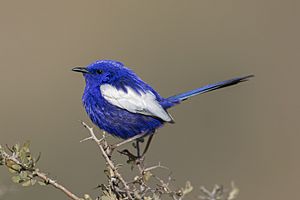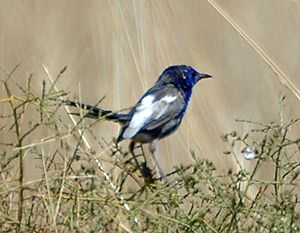White-winged fairywren facts for kids
Quick facts for kids White-winged fairywren |
|
|---|---|
 |
|
| Near Port Augusta, South Australia | |
| Conservation status | |
| Scientific classification | |
| Genus: |
Malurus
|
| Species: |
leucopterus
|
| Subspecies | |
|
|
 |
|
| White-winged fairywren range | |
The white-winged fairywren (Malurus leucopterus) is a small, colorful bird found in Australia. It belongs to the Australasian wren family, Maluridae. These birds live in the dry areas of Central Australia, from central Queensland and South Australia all the way to Western Australia.
Like other fairywrens, the males of this species look very different from the females, especially during the breeding season. Males grow bright, colorful feathers. Females are sandy-brown with light-blue tail feathers and are smaller than males. Breeding males have a bright-blue body, a black beak, and white wings. Young males look a lot like females. During spring and summer, a group of white-winged fairywrens might have one brightly colored older male with several smaller, brown birds, many of which are also male.
There are three types (subspecies) of white-winged fairywrens. One lives on the mainland of Australia. The other two live on islands off the coast of Western Australia: Dirk Hartog Island and Barrow Island. Males from these islands have black breeding feathers instead of blue ones.
White-winged fairywrens mainly eat insects. They also snack on small fruits and leaf buds. They like to live in heathland and dry scrubland areas where low bushes give them cover. They are cooperative breeding birds, meaning small groups of them work together to protect their home (territory) all year round. These groups usually have a breeding pair and several helper birds. The helpers are often young birds from previous years who stay with their family to help raise new chicks. When a male wren wants to impress a female, he might pick petals from flowers and show them to her.
Contents
About the White-winged Fairywren

White-winged fairywrens are among the smallest fairywrens. They are about 11 to 13.5 centimeters (4.3 to 5.3 inches) long. Males usually weigh between 7.2 and 10.9 grams (0.25 to 0.38 ounces), and females weigh between 6.8 and 11 grams (0.24 to 0.39 ounces). Their beaks are long, narrow, and pointed, which helps them find insects.
Male and Female Differences
Adult males and females look very different. The adult female is sandy-brown with a light blue tail and a pinkish-buff beak. The male in breeding season has a black beak, white wings and shoulders, and a body that is either bright cobalt blue or black, depending on where he lives. These white feathers stand out a lot when he flies or shows off during breeding season.
When the breeding season is over, the male's feathers change. He then looks similar to the female, but his beak is darker. Both males and females have long, thin tails that they hold upright.
Young birds are brown with pink-brown beaks and shorter tails. Young males will get blue tail feathers and darker beaks by late summer or autumn. By the next spring, all males are ready to breed.
Older males (around four years old) get their full bright blue or black breeding feathers. All adult males change their feathers twice a year: once before breeding season and again afterward. The blue feathers of breeding males are very shiny and reflect ultraviolet light. This makes them look even brighter to other fairywrens, who can see ultraviolet light.
Sounds and Calls
White-winged fairywrens make several different sounds. Their main call is a "reel," which both males and females use to mark their territory and keep their group together. It's a long song with "rising and falling notes." Even though it sounds soft, it can be heard far away over the low bushes.
They also make a harsh "trit" call to stay in touch, especially between mothers and their young, or to warn of danger. Adults use a high-pitched "peep" to contact birds that are farther away. Young birds and females near the nest make quiet, high-pitched "pips." Nestlings also make "gurgling" noises when they are being fed.
Where They Live and What They Like
The white-winged fairywren is very good at living in dry places. The mainland subspecies (M.l. leuconotus) is found across dry and semi-dry areas of Australia. They live in coastal Western Australia, stretching east to Queensland, and through parts of New South Wales, Victoria, and South Australia.
These birds often share their homes with other fairywren species. They like heathlands or treeless areas with low shrubs like saltbush and small bushes. They also live in grassy areas or floodplains with certain plants. The island subspecies live in similar habitats on Dirk Hartog Island and Barrow Island.
Behavior and Daily Life
White-winged fairywrens usually move by hopping, with both feet leaving and landing at the same time. They can also run very fast, especially when trying to distract predators. Their long tails help them balance. Their short, round wings are good for short flights but not for long journeys.
These fairywrens live in complex social groups. A group usually has 2 to 4 birds, often one male (brown or partly blue) and a breeding female. "Helpers" are young birds from previous years who stay with the family to help raise new chicks. These helpers can be male or female. Birds in a group sleep close together in thick bushes and groom each other.
Several smaller groups live within one larger territory, forming a "clan." One blue (or black) male is in charge of the clan and is the main breeding male. He nests with only one female and helps raise her young.
Each clan has its own area of land where they find food and protect it. The size of their territory, usually 4 to 6 hectares (10 to 15 acres), depends on how much rain and food are available. Smaller territories are found where there's plenty of food. Their feeding territories are larger in winter when they spend more time looking for food with the whole clan. White-winged fairywrens have much larger territories than other fairywren species.
Displays and Warnings
White-winged fairywrens use a "wing-fluttering" display in different situations. Females might do it when a male is trying to court them. Young birds do it to beg for food. Helpers might do it to older birds, and young males to older males. In this display, the bird lowers its head and tail, spreads and shakes its wings, and holds its beak open silently.
Both male and female white-winged fairywrens might use a "rodent-run" display to distract predators from their nests. They lower their head, neck, and tail, spread their wings, fluff their feathers, and run quickly while making a continuous alarm call.
Reproduction and Life Cycle
Fairywrens are known for having many chicks that are not fathered by the main male in the group. However, how white-winged fairywrens find mates is still being studied. Blue-feathered males have been seen outside their territory carrying pink or purple flower petals. On Barrow and Dirk Hartog islands, black-feathered males often carry blue petals. Carrying petals outside their own territory suggests they might be mating with females from other groups.
Another courtship display involves the male bowing deeply to the female. He touches the ground with his beak and spreads his feathers almost flat for up to 20 seconds. In this pose, his white feathers create a striking white band against his darker body.
Breeding females build their nests in spring. Nests are dome-shaped and made of spider webs, fine grasses, and soft plant material. They are usually 6 to 14 centimeters (2.4 to 5.5 inches) tall and placed in thick bushes close to the ground. Each nest has a small entrance on one side.
Females usually lay 3 to 4 eggs between September and January. The eggs hatch after about 14 days. Only the female sits on the eggs to keep them warm. However, the breeding male and helper birds all help feed the chicks and remove their waste.
Newly hatched chicks are born helpless and immediately open their mouths for food. They grow soft feathers and open their eyes by the third or fourth day. Chicks stay in the nest for 10 to 11 days. After leaving the nest, they are fed for another 3 to 4 weeks. Young birds then either stay to help raise the next group of chicks or move to a nearby territory. It's common for a pair to raise two groups of chicks in one breeding season. Helpers make it easier for the female, but they don't necessarily lead to more chicks overall.
Like other fairywrens, white-winged fairywrens can sometimes have their nests taken over by other birds, like the Horsfield's bronze cuckoo. These cuckoos lay their eggs in the fairywren's nest, and the fairywrens end up raising the cuckoo chicks.
What They Eat
White-winged fairywrens mostly eat insects. Their diet includes small beetles, bugs, moths, praying mantises, caterpillars, and spiders. Larger insects are usually given to the chicks by the breeding female and her helpers.
Adults and young birds look for food by hopping along the ground in the bushes. They might also eat seeds and fruits from plants like saltbush and new shoots of samphire. During spring and summer, they are active in short bursts throughout the day, singing as they look for food. Insects are plentiful then, so the birds can rest between feeding times. The group often rests together during the hottest part of the day. In winter, food is harder to find, so they have to spend most of the day looking for it.
Threats to White-winged Fairywrens
White-winged fairywrens and their young can be hunted by animals like red foxes and feral cats. Native birds like the Australian magpie, butcherbirds, laughing kookaburra, currawongs, crows, ravens, and shrike-thrushes also prey on them. Reptiles like goannas are also a threat.
Humans can also accidentally harm these birds. Many nests are stepped on during breeding season because they are hidden close to the ground and hard to see.
Images for kids
See also
 In Spanish: Maluro aliblanco para niños
In Spanish: Maluro aliblanco para niños



